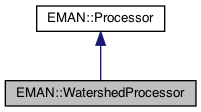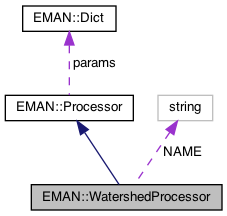'paints' a circle into the image at x,y,z with values inside r1 set to v1, values between r1 and r2 will be set to a value between v1 and v2, and values outside r2 will be unchanged More...
#include <processor.h>


Public Member Functions | |
| virtual EMData * | process (const EMData *const image) |
| To proccess an image out-of-place. More... | |
| virtual void | process_inplace (EMData *) |
| To process an image in-place. More... | |
| virtual string | get_name () const |
| Get the processor's name. More... | |
| virtual string | get_desc () const |
| Get the descrition of this specific processor. More... | |
| virtual TypeDict | get_param_types () const |
| Get processor parameter information in a dictionary. More... | |
 Public Member Functions inherited from EMAN::Processor Public Member Functions inherited from EMAN::Processor | |
| virtual | ~Processor () |
| virtual void | process_list_inplace (vector< EMData * > &images) |
| To process multiple images using the same algorithm. More... | |
| virtual Dict | get_params () const |
| Get the processor parameters in a key/value dictionary. More... | |
| virtual void | set_params (const Dict &new_params) |
| Set the processor parameters using a key/value dictionary. More... | |
Static Public Member Functions | |
| static Processor * | NEW () |
 Static Public Member Functions inherited from EMAN::Processor Static Public Member Functions inherited from EMAN::Processor | |
| static string | get_group_desc () |
| Get the description of this group of processors. More... | |
| static void | EMFourierFilterInPlace (EMData *fimage, Dict params) |
| Compute a Fourier-filter processed image in place. More... | |
| static EMData * | EMFourierFilter (EMData *fimage, Dict params) |
| Compute a Fourier-processor processed image without altering the original image. More... | |
Static Public Attributes | |
| static const string | NAME = "segment.watershed" |
Additional Inherited Members | |
 Public Types inherited from EMAN::Processor Public Types inherited from EMAN::Processor | |
| enum | fourier_filter_types { TOP_HAT_LOW_PASS , TOP_HAT_HIGH_PASS , TOP_HAT_BAND_PASS , TOP_HOMOMORPHIC , GAUSS_LOW_PASS , GAUSS_HIGH_PASS , GAUSS_BAND_PASS , GAUSS_INVERSE , GAUSS_HOMOMORPHIC , BUTTERWORTH_LOW_PASS , BUTTERWORTH_HIGH_PASS , BUTTERWORTH_HOMOMORPHIC , KAISER_I0 , KAISER_SINH , KAISER_I0_INVERSE , KAISER_SINH_INVERSE , SHIFT , TANH_LOW_PASS , TANH_HIGH_PASS , TANH_HOMOMORPHIC , TANH_BAND_PASS , RADIAL_TABLE , CTF_ } |
| Fourier filter Processor type enum. More... | |
 Protected Attributes inherited from EMAN::Processor Protected Attributes inherited from EMAN::Processor | |
| Dict | params |
Detailed Description
'paints' a circle into the image at x,y,z with values inside r1 set to v1, values between r1 and r2 will be set to a value between v1 and v2, and values outside r2 will be unchanged
- Parameters
-
xpoints x coordinates ypoints y coordinates zpoints z coordinates minval min value
Definition at line 7695 of file processor.h.
Member Function Documentation
◆ get_desc()
|
inlinevirtual |
Get the descrition of this specific processor.
This function must be overwritten by a subclass.
- Returns
- The description of this processor.
Implements EMAN::Processor.
Definition at line 7711 of file processor.h.
◆ get_name()
|
inlinevirtual |
Get the processor's name.
Each processor is identified by a unique name.
- Returns
- The processor's name.
Implements EMAN::Processor.
Definition at line 7701 of file processor.h.
References NAME.
◆ get_param_types()
|
inlinevirtual |
Get processor parameter information in a dictionary.
Each parameter has one record in the dictionary. Each record contains its name, data-type, and description.
- Returns
- A dictionary containing the parameter info.
Reimplemented from EMAN::Processor.
Definition at line 7716 of file processor.h.
References EMAN::EMObject::FLOAT, EMAN::EMObject::INT, and EMAN::TypeDict::put().
◆ NEW()
|
inlinestatic |
Definition at line 7706 of file processor.h.
◆ process()
To proccess an image out-of-place.
For those processors which can only be processed out-of-place, override this function to give the right behavior.
- Parameters
-
image The image will be copied, actual process happen on copy of image.
- Returns
- the image processing result, may or may not be the same size of the input image
Reimplemented from EMAN::Processor.
Definition at line 11885 of file processor.cpp.
References ImageDimensionException, InvalidValueException, EMAN::Processor::params, EMAN::Dict::set_default(), x, and y.
Referenced by process_inplace().
◆ process_inplace()
|
virtual |
To process an image in-place.
For those processors which can only be processed out-of-place, override this function to just print out some error message to remind user call the out-of-place version.
- Parameters
-
image The image to be processed.
Implements EMAN::Processor.
Definition at line 11879 of file processor.cpp.
References process().
Member Data Documentation
◆ NAME
|
static |
Definition at line 7726 of file processor.h.
Referenced by get_name().
The documentation for this class was generated from the following files: